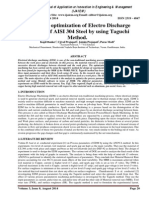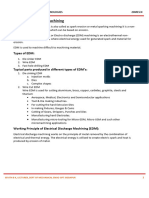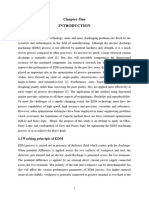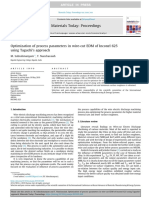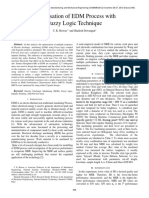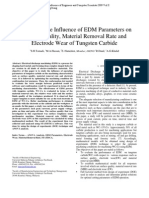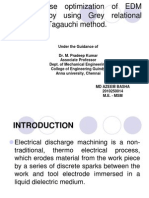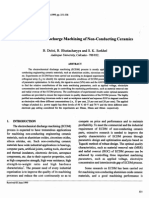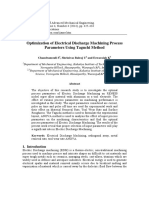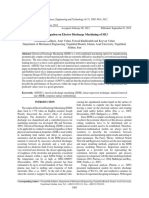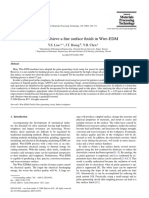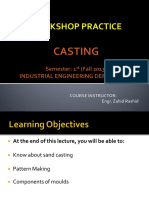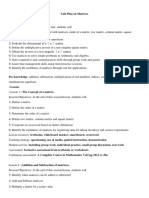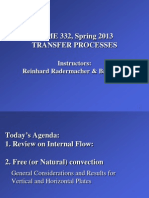Optimization of Surface Finish in EDM: Objective
Uploaded by
HuzaifaOptimization of Surface Finish in EDM: Objective
Uploaded by
HuzaifaOptimization of surface finish in EDM
1. Objective
2. Material selection
3. Procedure
4. Design of experiment
5. Analysis
6. Result and conclusion
Objective
In this research work
The important process parameters that have been selected are peak current, pulse on time, die
electric pressure and tool diameter. The outputs response is surface roughness (SR).
Response surface methodology(RSM) has been used to analyse the parameters and analysis
of variance (ANOVA) has been applied to identify the significant process parameters. The
influences of interaction of parameters have also been studied. The input parameters were
optimized in order to obtain minimum SR.
Introduction
EDM has wide application in automotive and aerospace industries Amorim et al. (2004)
describes the three process occurred in electrical discharge machining. This process consists
of three phases. Initially ignition breaks down the high voltage to low around 30 V. Peak
current increases the high energy and remove the material from the work piece. Finally,
plasma channel collapses and the removed particles are flushed away by flushing.
Components produced in EDM process are having exactly replica of the electrode shape.
Complex shaped products are manufactured in this process which cannot be produced by
conventional method. The work piece and tool electrode have no contact with each other.
Both are immersed in oil which act as coolant for the region. EDM oil should have high flash
point since the temperature developed is around 20,000 0C.
The Dielectric fluid flushes away the removed material. Among the electrical and non
electrical input parameters four factors have been chosen. These are
peak current [A],
pulse on time [B],
dielectric pressure [C] and
tool diameter [D].
Three levels have been selected in this experiment.
Material selection
Procedure
steel have been prepared to the size of 60×80×10 mm. machined by Cast Copper electrode
according to the design matrix and output responses have been found out. Grace – EDM
machine has been used to machine the work piece.
Design of experiment
Table 1 furnishes the various factor and their levels
Level
S.No Input parameters Unit
1 2 3
1 A. Peak current Amp
2 B. Pulse on time microsec
C. Di-electric
3 Kg/cm2
pressure
4 D. Tool Diameter mm
Experiment on the EDM was conducted as per the design matrix. Design of Experiment
(DOE) is mainly adopted to minimise the number of experiments and also to achieve
optimum condition. Response Surface Methodology (RSM) is a statistical technique for
modeling and it optimizes the output response variables.
Analysis and Results
Significant Parameter
The significant parameters have been identified for EN8 machined by Cast Copper electrode.
For SR peak current, dielectric pressures, tool diameter and pulse on time are significant.
Co-efficient of determinant
The R2 value is above 0.90 for both work pieces. The Adjusted R2 is the modified R2 which
is used for the terms in the model. AdjR2 is reasonably agreement with R2 for both
electrodes. The R2 values are tabulated in the Table
Output R- Adj-R- Pre-R-
S.No
Response squared squared squared
Surface
1
Roughness
Influence of input parameter on response
The influenced parameters are identified for Cast Copper electrode. Increase of pulse on time
increase the SR value.
Model Graph
Optimization
EDM is a valuable tool for making complex shaped parts which cannot be done by Cast
machining. It is necessary to reduce the machining time in order to increase the production
rate. It is very essential to optimize the input parameters to yield minimum SR. In single
objective optimization only one solution has been obtained. While comparing Cast and
Sintered Copper electrodes for EN8 material, it has been observed for sintered copper
electrode high Peak current, high Pulse on time, marginally low dielectric pressure and larger
tool diameter yields maximum MRR and minimum TWR but marginally higher surface
roughness.
Optimization Table
Input /output Optimized
S.No Parameters value Units
1 Peak current Amps
2 Pulse on time Microsec
3 Di-electric pressure Kg/Cm2
4 Tool diameter mm
5 Surface Roughness μm
Conclusion
1. The significant parameters have been identified from ANOVA Table.
2. Coefficient of determinant (R2) value is above 0.90.
3. The predicted R2 value is reasonably agreement with Adj R2.
4. The significance of interaction of parameters have been studied.
You might also like
- The Optimization of Micro EDM Milling of Ti-6Al-4V Using A GreyNo ratings yetThe Optimization of Micro EDM Milling of Ti-6Al-4V Using A Grey9 pages
- Application of Metal Powder To Improve Metal Removal Rate inNo ratings yetApplication of Metal Powder To Improve Metal Removal Rate in7 pages
- Effect of Machining Parameters On Surface Roughness of H13 Steel in Edm Process Using Powder Mixed FluidNo ratings yetEffect of Machining Parameters On Surface Roughness of H13 Steel in Edm Process Using Powder Mixed Fluid3 pages
- Modeling and Optimization of Wire EDM Process: K. Kumar, R. RavikumarNo ratings yetModeling and Optimization of Wire EDM Process: K. Kumar, R. Ravikumar14 pages
- Comparative Performance of Wet and Near-Dry Edm Process For Machining of Oil Hardned Non Sinking Steel MaterialNo ratings yetComparative Performance of Wet and Near-Dry Edm Process For Machining of Oil Hardned Non Sinking Steel Material10 pages
- Parameter Optimization of Electro Discharge Machine of AISI 304 Steel by Using Taguchi MethodNo ratings yetParameter Optimization of Electro Discharge Machine of AISI 304 Steel by Using Taguchi Method5 pages
- A Review of Research On Improvement andNo ratings yetA Review of Research On Improvement and18 pages
- Investigation Study of Electrical Discharge Machining Parameters On Material Removal Rate For AISI M2 MaterialNo ratings yetInvestigation Study of Electrical Discharge Machining Parameters On Material Removal Rate For AISI M2 Material5 pages
- 12.Eng-Parametric Optimization of Wedm Using - K.B. RaiNo ratings yet12.Eng-Parametric Optimization of Wedm Using - K.B. Rai8 pages
- Electrical Discharge Machining: Dr. Kuppan P VIT UniversityNo ratings yetElectrical Discharge Machining: Dr. Kuppan P VIT University46 pages
- Materials Today: Proceedings: M. Subrahmanyam, T. NancharaiahNo ratings yetMaterials Today: Proceedings: M. Subrahmanyam, T. Nancharaiah5 pages
- Materials Today: Proceedings: M. Subrahmanyam, T. NancharaiahNo ratings yetMaterials Today: Proceedings: M. Subrahmanyam, T. Nancharaiah5 pages
- A Study of Electrical Discharge Grinding Using A Rotary Disk ElectrodeNo ratings yetA Study of Electrical Discharge Grinding Using A Rotary Disk Electrode9 pages
- Optimization of Various Machining Parameters of Electrical Discharge Machining (EDM) Process On AISI D2 Tool Steel Using Hybrid Optimization MethodNo ratings yetOptimization of Various Machining Parameters of Electrical Discharge Machining (EDM) Process On AISI D2 Tool Steel Using Hybrid Optimization Method9 pages
- Current Measurement of Resistance Spot Welding Using DSP: Wen-Ren Yang and Chau-Shing WangNo ratings yetCurrent Measurement of Resistance Spot Welding Using DSP: Wen-Ren Yang and Chau-Shing Wang6 pages
- Meena2017 Article Micro-EDMMultipleParameterOptiNo ratings yetMeena2017 Article Micro-EDMMultipleParameterOpti8 pages
- Optimisation of EDM Process With Fuzzy Logic Technique: C. K. Biswas and Shailesh DewanganNo ratings yetOptimisation of EDM Process With Fuzzy Logic Technique: C. K. Biswas and Shailesh Dewangan4 pages
- Parametric Study of Dry WEDM Using Taguchi Method: S.Boopathi, K.Sivakumar, R.KalidasNo ratings yetParametric Study of Dry WEDM Using Taguchi Method: S.Boopathi, K.Sivakumar, R.Kalidas6 pages
- MMG - International Conference On Mechanical and Industrial EngineeringNo ratings yetMMG - International Conference On Mechanical and Industrial Engineering4 pages
- Parametric Optimization of Electrochemical Machining Using Signal-To-Noise (S/N) RatioNo ratings yetParametric Optimization of Electrochemical Machining Using Signal-To-Noise (S/N) Ratio8 pages
- Electrode Wear Rate of Graphite Electrode During Edm Process On Titanium Alloy M. A. R. Khan, M. M. Rahman and K. KadirgamaNo ratings yetElectrode Wear Rate of Graphite Electrode During Edm Process On Titanium Alloy M. A. R. Khan, M. M. Rahman and K. Kadirgama6 pages
- A Review Paper On (EDM) Electrical Discharge MachiningNo ratings yetA Review Paper On (EDM) Electrical Discharge Machining3 pages
- Applied Mathematical Modelling: Sameh S. HabibNo ratings yetApplied Mathematical Modelling: Sameh S. Habib11 pages
- Application of The Taguchi Technique For Wedm Parameters For Tungsten CarbideNo ratings yetApplication of The Taguchi Technique For Wedm Parameters For Tungsten Carbide10 pages
- Experimental Investigation of Machining Parameters For EDM Using Rectangular Shaped Electrode of en 31 Steel0% (1)Experimental Investigation of Machining Parameters For EDM Using Rectangular Shaped Electrode of en 31 Steel3 pages
- A Brief Review of Die Sinking Electrical Discharging Machining Process Towards AutomationNo ratings yetA Brief Review of Die Sinking Electrical Discharging Machining Process Towards Automation7 pages
- Multi Response Optimization of EDM Parameters by Using Grey Relational Analysis and Tagauchi MethodNo ratings yetMulti Response Optimization of EDM Parameters by Using Grey Relational Analysis and Tagauchi Method12 pages
- Analysis of Influence of micro-EDM Parameters On MRR, TWR and Ra in Machining Ni-Ti Shape Memory AlloyNo ratings yetAnalysis of Influence of micro-EDM Parameters On MRR, TWR and Ra in Machining Ni-Ti Shape Memory Alloy6 pages
- Department of Electronics & TelecommunicationNo ratings yetDepartment of Electronics & Telecommunication12 pages
- Optimization of Electrical Discharge Machining Process Parameters Using Taguchi MethodNo ratings yetOptimization of Electrical Discharge Machining Process Parameters Using Taguchi Method10 pages
- Investigation On Electro Discharge Machining of H13No ratings yetInvestigation On Electro Discharge Machining of H1310 pages
- A Study To Achieve A Fine Surface Finish in Wire-EDM: Y.S. Liao, J.T. Huang, Y.H. ChenNo ratings yetA Study To Achieve A Fine Surface Finish in Wire-EDM: Y.S. Liao, J.T. Huang, Y.H. Chen7 pages
- Experimental Investigation of EDM Parameters for TiCNi CermetNo ratings yetExperimental Investigation of EDM Parameters for TiCNi Cermet5 pages
- Parametric Optimization of Machining Parameters of AISI D3 Tool Steel Using Wire Cut Electric Discharge Machining - A Taguchi Based ApproachNo ratings yetParametric Optimization of Machining Parameters of AISI D3 Tool Steel Using Wire Cut Electric Discharge Machining - A Taguchi Based Approach7 pages
- Determination of Material Removal Rate in Electro Discharge Machining Through Copper ElectrodeNo ratings yetDetermination of Material Removal Rate in Electro Discharge Machining Through Copper Electrode7 pages
- Electromagnetic Compatibility (EMC) Design and Test Case AnalysisFrom EverandElectromagnetic Compatibility (EMC) Design and Test Case AnalysisNo ratings yet
- Chapter 10 - Grain Growth, Sintering and VitrificationNo ratings yetChapter 10 - Grain Growth, Sintering and Vitrification34 pages
- Fault Analysis in Transmission System Using Matlab89% (46)Fault Analysis in Transmission System Using Matlab50 pages
- Simple Linear Regression: Definition of TermsNo ratings yetSimple Linear Regression: Definition of Terms13 pages
- Jozette Roberts Unit Plan On Matrices PortfolioNo ratings yetJozette Roberts Unit Plan On Matrices Portfolio5 pages
- Advanced Thermodynamics: Exergy / AvailabilityNo ratings yetAdvanced Thermodynamics: Exergy / Availability64 pages
- ENME 332, Spring 2013 Transfer Processes: Instructors: Reinhard Radermacher & Bao YangNo ratings yetENME 332, Spring 2013 Transfer Processes: Instructors: Reinhard Radermacher & Bao Yang18 pages








